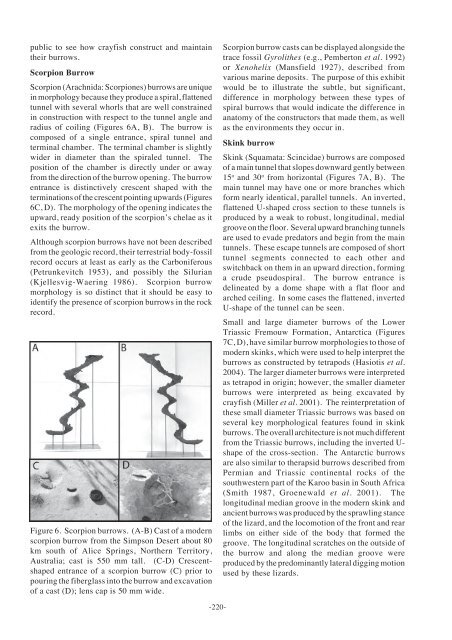Continental trace fossils and museum exhibits - Geological Curators ...
Continental trace fossils and museum exhibits - Geological Curators ...
Continental trace fossils and museum exhibits - Geological Curators ...
Create successful ePaper yourself
Turn your PDF publications into a flip-book with our unique Google optimized e-Paper software.
public to see how crayfish construct <strong>and</strong> maintaintheir burrows.Scorpion BurrowScorpion (Arachnida: Scorpiones) burrows are uniquein morphology because they produce a spiral, flattenedtunnel with several whorls that are well constrainedin construction with respect to the tunnel angle <strong>and</strong>radius of coiling (Figures 6A, B). The burrow iscomposed of a single entrance, spiral tunnel <strong>and</strong>terminal chamber. The terminal chamber is slightlywider in diameter than the spiraled tunnel. Theposition of the chamber is directly under or awayfrom the direction of the burrow opening. The burrowentrance is distinctively crescent shaped with theterminations of the crescent pointing upwards (Figures6C, D). The morphology of the opening indicates theupward, ready position of the scorpion’s chelae as itexits the burrow.Although scorpion burrows have not been describedfrom the geologic record, their terrestrial body-fossilrecord occurs at least as early as the Carboniferous(Petrunkevitch 1953), <strong>and</strong> possibly the Silurian(Kjellesvig-Waering 1986). Scorpion burrowmorphology is so distinct that it should be easy toidentify the presence of scorpion burrows in the rockrecord.Figure 6. Scorpion burrows. (A-B) Cast of a modernscorpion burrow from the Simpson Desert about 80km south of Alice Springs, Northern Territory,Australia; cast is 550 mm tall. (C-D) Crescentshapedentrance of a scorpion burrow (C) prior topouring the fiberglass into the burrow <strong>and</strong> excavationof a cast (D); lens cap is 50 mm wide.Scorpion burrow casts can be displayed alongside the<strong>trace</strong> fossil Gyrolithes (e.g., Pemberton et al. 1992)or Xenohelix (Mansfield 1927), described fromvarious marine deposits. The purpose of this exhibitwould be to illustrate the subtle, but significant,difference in morphology between these types ofspiral burrows that would indicate the difference inanatomy of the constructors that made them, as wellas the environments they occur in.Skink burrowSkink (Squamata: Scincidae) burrows are composedof a main tunnel that slopes downward gently between15 o <strong>and</strong> 30 o from horizontal (Figures 7A, B). Themain tunnel may have one or more branches whichform nearly identical, parallel tunnels. An inverted,flattened U-shaped cross section to these tunnels isproduced by a weak to robust, longitudinal, medialgroove on the floor. Several upward branching tunnelsare used to evade predators <strong>and</strong> begin from the maintunnels. These escape tunnels are composed of shorttunnel segments connected to each other <strong>and</strong>switchback on them in an upward direction, forminga crude pseudospiral. The burrow entrance isdelineated by a dome shape with a flat floor <strong>and</strong>arched ceiling. In some cases the flattened, invertedU-shape of the tunnel can be seen.Small <strong>and</strong> large diameter burrows of the LowerTriassic Fremouw Formation, Antarctica (Figures7C, D), have similar burrow morphologies to those ofmodern skinks, which were used to help interpret theburrows as constructed by tetrapods (Hasiotis et al.2004). The larger diameter burrows were interpretedas tetrapod in origin; however, the smaller diameterburrows were interpreted as being excavated bycrayfish (Miller et al. 2001). The reinterpretation ofthese small diameter Triassic burrows was based onseveral key morphological features found in skinkburrows. The overall architecture is not much differentfrom the Triassic burrows, including the inverted U-shape of the cross-section. The Antarctic burrowsare also similar to therapsid burrows described fromPermian <strong>and</strong> Triassic continental rocks of thesouthwestern part of the Karoo basin in South Africa(Smith 1987, Groenewald et al. 2001). Thelongitudinal median groove in the modern skink <strong>and</strong>ancient burrows was produced by the sprawling stanceof the lizard, <strong>and</strong> the locomotion of the front <strong>and</strong> rearlimbs on either side of the body that formed thegroove. The longitudinal scratches on the outside ofthe burrow <strong>and</strong> along the median groove wereproduced by the predominantly lateral digging motionused by these lizards.-220-
















